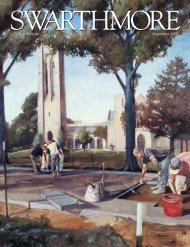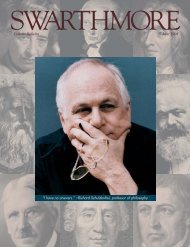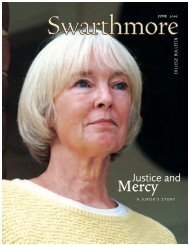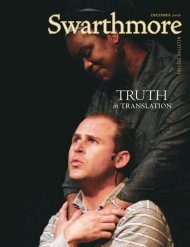SWARTHMORE
Swarthmore College Bulletin (September 2000) - ITS
Swarthmore College Bulletin (September 2000) - ITS
- No tags were found...
Create successful ePaper yourself
Turn your PDF publications into a flip-book with our unique Google optimized e-Paper software.
ONE PROJECT THAT IS CLOSE TO STEVE IZENOUR’S HEART IS THE 1985RENOVATION OF CLOTHIER HALL TO INCLUDE THE TARBLE STUDENT CENTER.“TARBLE IN CLOTHIER” INVOLVED A BOLD PLAN THAT HOLLOWED OUT THEEXISTING CLOTHIER THEATER, WHICH VENTURI DESCRIBED AS “BUILDINGA SHIP IN A BOTTLE” TO CREATE AN ENTIRELY NEW SPACE.TOM BERNARDMARTIN NATVIGshelf of design awards, including an American Institute ofArchitects award for a house on the Long Island Sound thatIzenour designed in 1982 for his parents.He admits to being a workaholic who also organizes manyof his firm’s design competitions and graphic displays andbalances what Scott Brown calls “the firm’s tendency towardgravitas with an exuberance, wit, and intelligence.”Says Tessa Izenour: “As early as I can remember, my fatherhas been working on dozens of different things at once.Though I get much of my artistic sense from my mother,from my father I get this appreciation for the visual, howthings look, and why they look the way they do.”Adds John, who runs the firm’s graphic computers, “myfather has an irreverent side that he hides, but it comes outin different ways. He has a playfulness that I can see in theChildren’s Garden or in the Ben Franklin Bridge lighting.When things get tense, he can come into a situation and saysomething funny that’ll usually solve the problem withoutanybody thinking the solution came from him.”Izenour continues to teach because “I have a lot ofrespect for the idea of discipleship—that you can bumpalong aimlessly in life until you meet the right teacher, and,like Hedley Rhys did for me, he’s there to give you just whatyou need to get to the next level and find your own voice.Also, there’s a lot of very interesting stuff out there that’sworth studying because of what it reveals about ourselves.”He tends to avoid studying contemporary architecturebecause “despite everything that happened with postmodernismwhen Bob started talking about it, we’re still living ina modernist world. Architects are still mostly ignoring thecultural or human context that a building inhabits and goingfor the guts ’n glory stuff that flatters the client and winscommissions. I run into entirely too many architects whosay, ‘Uh-huh, we get it: fancy facades, wild colors, weirdshapes, decoration that doesn’t look like it belongs on abuilding and maybe an ironic cultural reference thrown in.’They’ve come up with buildings that look like they’re goingtrick-or-treating on Halloween. Or they go the expressiveroute and make buildings that go so far away from beingfunctional that they end up looking like oversized abstractlawn sculpture, you know, the stuff people put in their yardthat makes you stop and say, ‘What’s that?’ rather than takea good look at that great pink flamingo.”That some people stop and say similar things aboutIzenour’s buildings is not necessarily a bad thing, Izenoursays, taking refuge in Venturi’s famous quote that because nowork of art is ever accepted completely in its time, “whatmatters is only that the right people hate it.”“I wouldn’t mind it if everybody loved what we did,”Izenour says. “But, if you really hate something, you have thepotential to learn from it. At worst, you learn why you hatesomething. At best, you come up with new ways of appreciatingthings that you used to think were unworthy.” ■Bill Kent saw his first VSBA building as a student atOberlin College. He is the author of five books andteaches novel writing at the University of Pennsylvania.S E P T E M B E R 2 0 0 029
















